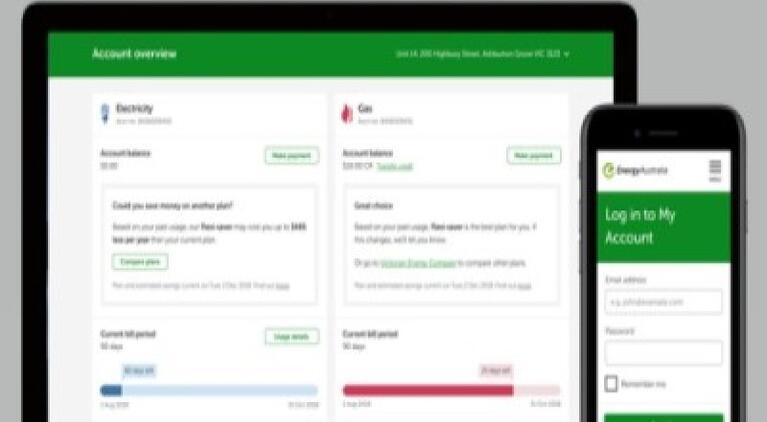Many changes have happened in energy in Victoria since 1 July 2019, such as the Victorian Default Offer (or VDO), best offer messaging and GST changes.
We’ve outlined these changes below but it’s worth noting that there could be more to come. We’ll keep you updated.
Victorian Default Offer
From 1 July 2019, energy companies were required to make a Victorian Default Offer (VDO) for Victorian residential and small business customers on a standing offer electricity plan. The Victorian Default Offer rates are set by the Essential Services Commission (ESC) in Victoria.
Our Standing Offer Home and Standing Offer Business plans are standing offers that have no discounts. If you are on these standing offer plans for your electricity for selected tariff types, your rates will be set to reflect the Victorian Default Offer.
Here are the tariff types currently on the Victorian Default Offer rates.
| Residential electricity customers | Flat and controlled load rates Time of use rates |
| Business electricity customers (uses less than 40 MWh per year) | Flat rate Time of use rates |
The Victorian Default Offer is a regulated price for electricity that will replace standing offer tariffs advertised by energy companies. The Victorian Default Offer price is set annually for each electricity distribution zone based on an average customer’s usage every January.
It will also serve as a comparison for discounted electricity offers. For example, if an energy company is offering a ten per cent discount, that discount must be compared to the Victorian Default Offer.
The Victorian Government introduced the Victorian Default Offer to make it easier for consumers and businesses to compare energy plans across different retailers.
It’s intended as a safety net for residential and small business customers who don’t have the time or access to compare market offers provided by electricity retailers. It also ensures that customers who can’t or don’t want to engage with their energy retailer will pay lower energy costs.
This is the average annual electricity cost for a Victorian household or small business, based on the Victorian Default Offer rates for the relevant electricity distribution area. This is used as a benchmark price to compare between retailers electricity offers.
It was introduced to make it easier for consumers to make ‘apples with apples’ comparisons between different energy retailer offers for electricity.
The Victorian Default Offer prices has been calculated for each electricity network area based on the average usage and is set by the Essential Services Commission (ESC).
FLAT TARIFFS:
| Distributor | Residential Flat tariffs | Residential flat tariff with controlled load | Small business flat tariffs |
Usage kWh Price | Usage kWh Price | Usage kWh Price | |
| AusNet | 4,000 $1,907 | 6,000 $2,387 | 20,000 $8,278 |
| CitiPower | 4,000 $1,546 | 6,000 $1,948 | 20,000 $5,842 |
| Jemena | 4,000 $1,638 | 6,000 $2,101 | 20,000 $6,860 |
| Powercor | 4,000 $1,703 | 6,000 $2,127 | 20,000 $6,435 |
| United Energy | 4,000 $1,579 | 6,000 $2,000 | 20,000 $6,078 |
Usage is kWh per year and all prices include GST.
There are three components to comparing a reference price.
- The estimated annual electricity cost for EnergyAustralia’s offer for an average household in a distribution zone
- The annual Victorian Default Offer cost for an average household in the distribution zone (this is the reference price)
- The difference between the annual cost of our offer against the annual cost of the Victorian Default Offer (that is, the reference price), shown in either dollars or as a percentage difference.
For example, here’s a flat tariff electricity offer in the CitiPower area:
Lowest possible price for an average household in CitiPower, based on a residential flat tariff using 4,000 kWh per year.
| EnergyAustralia’s plan offer | $1,391 |
| Victorian Default Offer price | $1,546 |
This means EnergyAustralia’s flat tariff offer is 10% less than the Victorian Default Offer (VDO) for annual electricity usage for an average household in the CitiPower network area. This is an example, showing a comparison to the current VDO. Your actual cost will depend on your actual usage over the year and the plan you’re on.
TIME OF USE TARIFFS:
| Distributor | Time of use tariffs | Time of use tariff with controlled load | Small business flat tariffs |
| Usage Price | Usage Price | Usage Price | |
| AusNet | 4,000 $1,777 | 6,000 $2,258 | 20,000 $6,709 |
| CitiPower | 4,000 $1,524 | 6,000 $1,926 | 20,000 $5,753 |
| Jemena | 4,000 $1,580 | 6,000 $2,043 | 20,000 $6,186 |
| Powercor | 4,000 $1,667 | 6,000 $2,091 | 20,000 $6,551 |
| United Energy | 4,000 $1,548 | 6,000 $1,969 | 20,000 $5,999 |
For example, here’s a time of use electricity offer in the CitiPower zone:
Lowest possible price for an average household in CitiPower, based on a residential time of use tariff using 4,000 kWh per year
| EnergyAustralia’s plan offer | $1,447 |
| Victorian Default Offer price | $1,524 |
This means EnergyAustralia’s time of use tariff offer is 5% less than the Victorian Default Offer (VDO) for annual electricity usage for an average household in the CitiPower network area. This is an example, showing a comparison to the current VDO. Your actual cost will depend on your actual usage over the year and the plan you’re on.
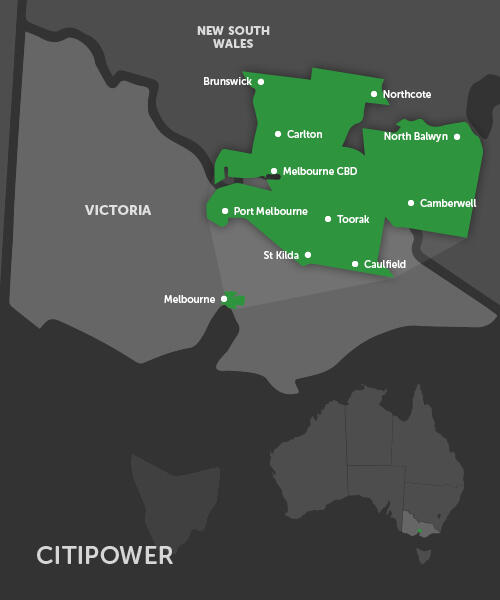
Electricity plans are now easy to compare – just look at the percentage difference from the reference price. The bigger the discount off the reference price, the better the deal for you.
Your energy distributor is the company responsible for the poles, wires and gas pipes in your area. You’ll find the name of your distributor at the top right hand side of your energy bill.
There are five distribution zones impacted by the Victorian Default Offer across Victoria.
CitiPower owns and manages 157 square kilometres of electricity poles and wires in the network. It provides power for more than 330,000 customers in Melbourne’s CBD and inner suburbs.

Powercor manages more than half a million poles and over 88,000 kilometres of power lines, providing electricity for nearly 820,000 homes and businesses in central and western Victoria, as well as Melbourne’s western suburbs.
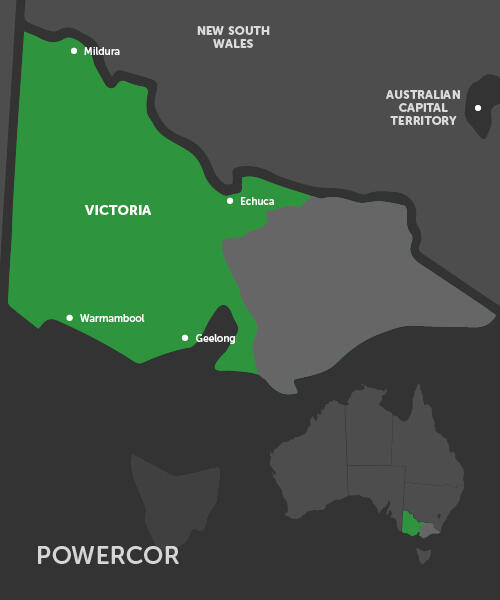
Jemena owns the poles and wires powering over 343,000 homes and businesses in Melbourne’s inner north-west.

United Energy distributes electricity to more than 660,000 homes and businesses across east and south east Melbourne and the Mornington Peninsula.
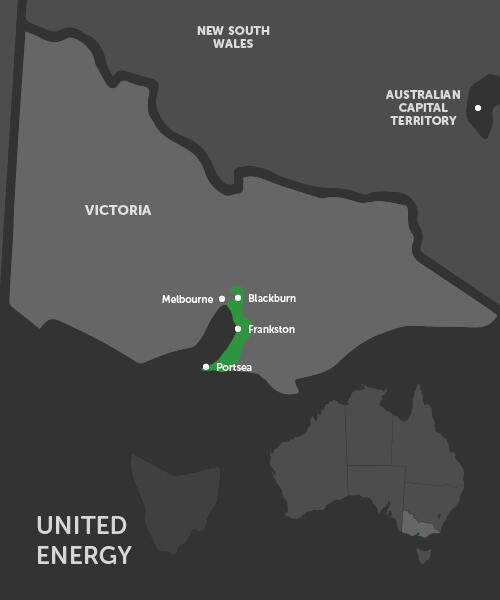
AusNet Services looks after the poles and wires for 740,000 homes and businesses in Melbourne's north and east and across all of eastern and north-eastern Victoria.
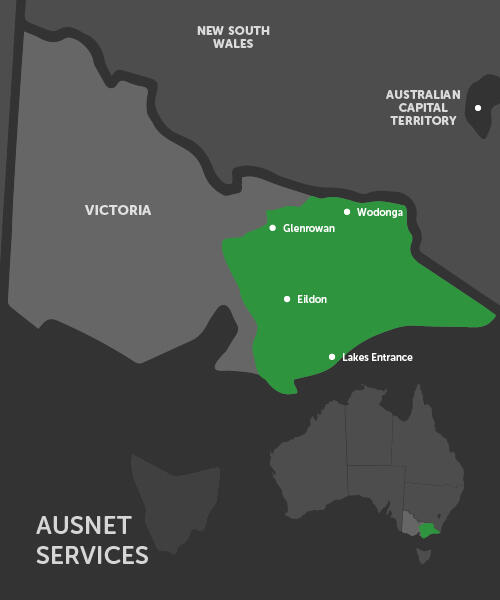
It’s a tariff where you’re charged the same rate for electricity throughout the day and night. There is no distinction made between peak and off-peak periods like time of use tariffs.
A flat rate tariff is usually lower than peak but higher than off peak and shoulder rates.
What is a time of use tariff?
With time of use tariffs, different usage rates are charged for the electricity you use at different times: off peak and peak.
- Off peak – charged when the electricity network has low usage, such as overnight or during the day when the grid is receiving a lot of excess solar.
- Peak – charged when the electricity network has high usage, such as in the late afternoon or evening on weekdays or on the weekends.
Controlled load electricity refers to electricity being used by a stand-alone item, like an electric hot water service, electric slab heating and irrigation pumps. Controlled loads are recorded by a separate meter and can be billed as an off-peak rate.
Find out more about controlled load.
Tariffs are also known as rates. For more information go to our tariff pages.
Our Standing Offer Home and Standing Offer Business plans are standing offers that have no discounts. It applies to a customer who does not actively choose an energy plan with an energy company.
When someone moves into a premises and the electricity or gas is already connected, any consumption is charged at the standing offer rates until the resident chooses another energy plan.
If you’re on a Standing Offer Home or Standing Offer Business electricity plan, you’re on the Victorian Default Offer for selected tariff types
The Victorian Default Offer prices are set by the Essential Services Commission (ESC) in Victoria and are usually reviewed every year in July.
The Victorian Default Offer rates will be set by the Essential Services Commission (ESC) in Victoria. The ESC will review the reference price usually once a year.
From 1 July 2019, all electricity Victorian households and small businesses can access the Victorian Default Offer, including customers in embedded networks.
The Energy Services Commission doesn’t set Victorian Default Offer prices for all tariff types. If you’re on one of these non-Victorian Default Offer tariffs, you may need to change your tariff type to access the Victorian Default Offer. However, our advertised plans are usually better than Victorian Default Offer prices. In most cases you won’t need to change your tariff type.
See our home and business plans to check that you’re on the best plan for your needs.
This is a type of electricity infrastructure generally managed by the building owner. A person living in an apartment complex, retirement home, caravan park or tenant in a shopping centre may be receiving their electricity via an embedded network.
Yes, the amount you can be charged in an embedded network for electricity is capped. Since 1 September 2020, the Victorian Default Offer sets the maximum price for all households and small businesses in embedded networks, provided they consume less than 40 megawatt hours of electricity per year.
Generally, yes. As unmetered supply devices are charged on a standing offer electricity tariff, these rates need to be consistent with the Victorian Default Offer prices.
What is unmetered electricity supply?
We supply businesses and councils in the Ausnet area in Victoria with electricity where a physical meter isn’t available. This is called ‘unmetered supply’. What this does is it powers essential services such as streetlights, telecommunications boxes, bus shelters, traffic lights and security lights for example – which we refer to as ‘devices’.
The unmetered electricity supply to these sites is non-contestable, which means we’re the only electricity retailer that can supply this service in this distribution area.
If you’re on a standing offer and on the tariff types that changed to the Victorian Default Offer rates, you would have been contacted by us to let you know that your plan rates changed.
If you're not on a standing offer and you want to access the Victorian Default Offer, you'll need to sign up to Standing Offer Home or Standing Offer Business plan on the following rate types:

Standing offer rates and Victorian Default Offer rates are generally not our best priced plans.
Our current retail market plans can be found for residential customers and for business customers.
No, the Victorian Default Offer doesn’t apply to gas.
In New South Wales, South Australia and south east Queensland, it’s called the Default Market Offer. Find out more about these changes.
In the ACT, it’s called the reference price. Find out more about these changes.
- See our home and business plans to check that you’re on the best plan for your needs.
- We have a range to suit everyone, whether you’re looking for great rates, flexibility or price certainty.
How do I find which plan I’m on?
- If you’re not sure what plan you’re on now, go to ‘Your electricity usage and service calculation’ section on page 3 of your home or business bill.
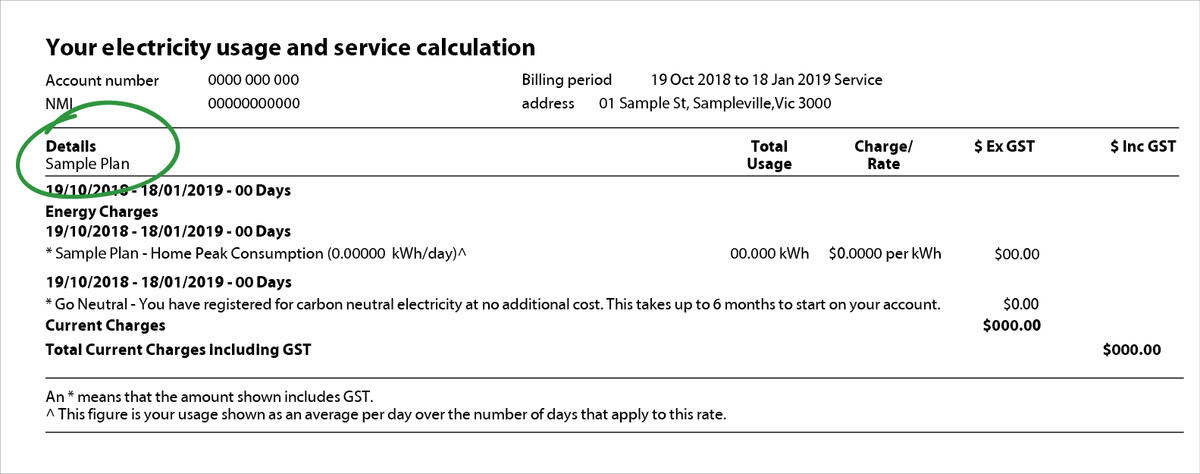
Best offer message
Between 1 July and 1 October 2019, all energy retailers will start to include a best offer message on the front of their bills. This message will inform you whether or not you’re on the best priced advertised plan available from us for your needs. The message you get will be based on your energy usage over the past 12 months or an estimate if we don’t have 12 months usage and whether or not you can save more than $22 (including GST) a year.
You’ll receive either of the below messages on the front of your bill to let you know whether you’re on our
best available plan or not, based on a minimum saving of $22 incl. GST a year.
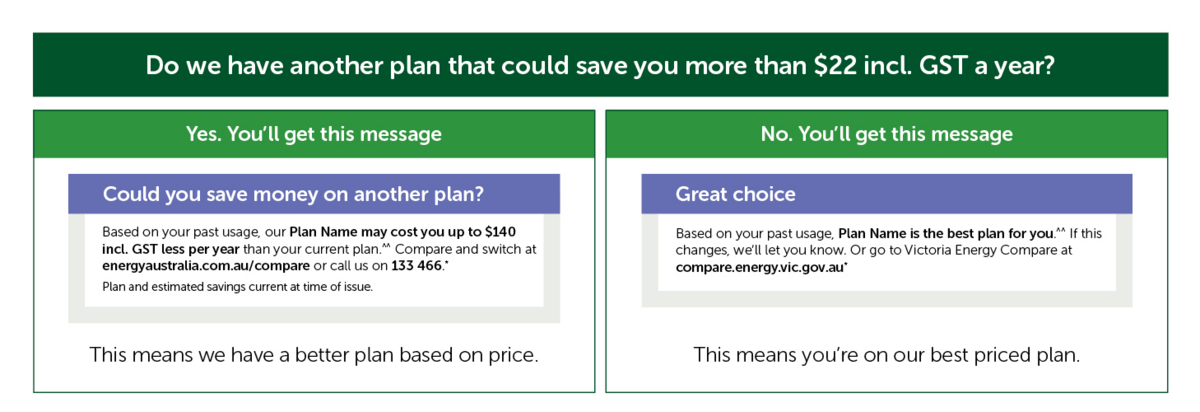
It was introduced to help you understand if you’re on the best priced advertised plan or not. All energy retailers are required to have these messages on their bills after 1 July 2019.
If we have another plan that could save you more than $22 a year (including GST) then we’ll tell you. If not, we’ll let you know that you’re on our best priced advertised plan available for your needs.
This mean you’re on our best priced advertised plan, and we don’t have an alternative that can save you more than $22 a year.
Yes. The message will either be that you're on the best priced advertised plan with us, or that you could save an estimate of more than $22 (including GST) a year on one of our other best priced advertised plans.
If your circumstances change, you can still contact us to discuss other plan options.
The best offer message is calculated at a point in time, based on the plans we have available and an estimated usage information we have for you. Our available plans and your usage can both change.
Feel free to contact us and we can chat about your energy account needs.
GST
We have now included a statement on your bill to remind you of this. It can be found here.
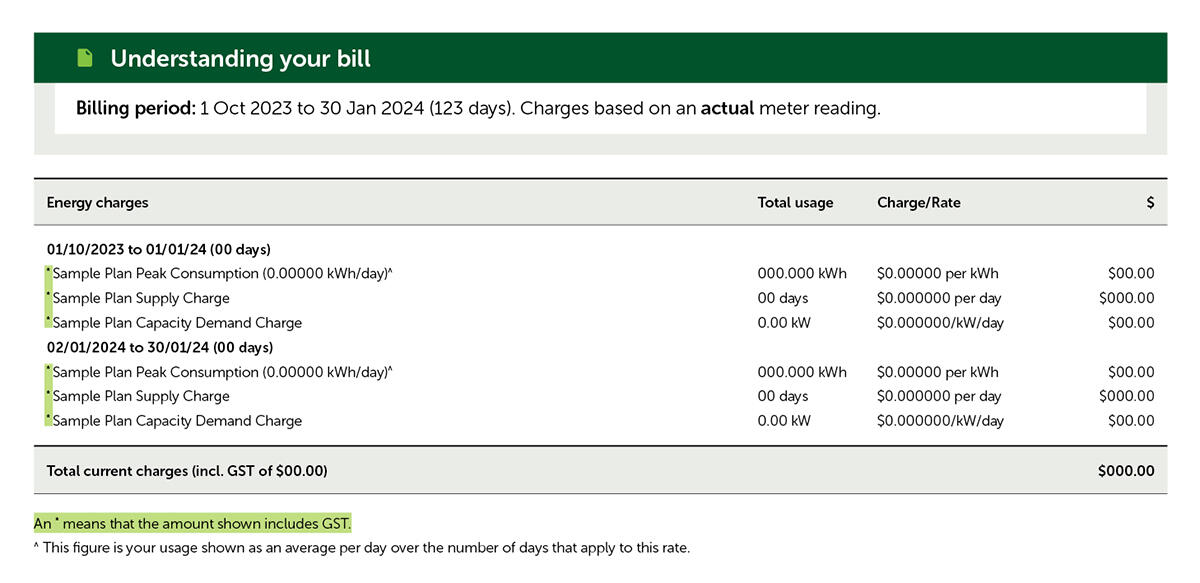
There will be no change to how you include the GST on your energy purchases in your BAS.

